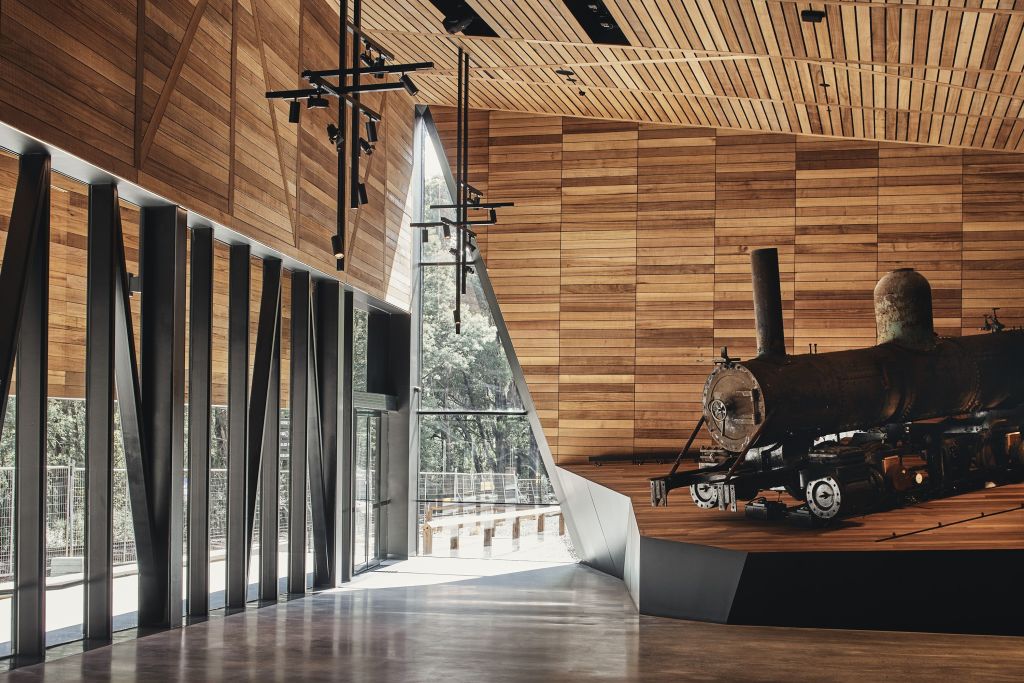A heroic completion achieved during the hassles of Victoria’s COVID lockdowns, the new visitor centre for one of Australia’s most cherished tourism experiences has won a prestigious international architecture award.
For the dramatic, if dark and erratic, form of the $20 million Puffing Billy Visitor Centre in the Dandenong Ranges, Terroir, has won one of the Chicago Athenaeum International Architecture Awards for 2022.
And while not the first award from the august American institute for the Sydney, Hobart and Copenhagen-based studio that is noted for its often daringly responsive projects, it is a welcome and novel win for the mainly volunteer folk who maintain and run the heritage narrow-gauge Puffing Billy fleet through the tree fern and mountain ash forests in the range that backdrops Melbourne.
As chief executive Peter Abbott commented, “it puts Puffing Billy on the world stage”.
Back in 2017, Terroir won the task of giving the little train with the steam puffing stack and piercing whistle a new multifaceted interpretive function and cafe building at one of the prettiest of the line’s stations beside Emerald Lake Park.
And the concept that won the job – a single-level black building almost zig-zagging along beside the train line that makes a feature of the platform, but more theatrically, that has a genuine 20-tonne locomotive apparently busting through the wall inside the centre – was successfully carried through to the eventual realisation of the project.
“The premise of our competition entry” says the project’s lead, Emily Slevin, “was to hero the existing qualities of Puffing Billy and not to overshadow it. The form of the building came about as a response to the European-style landscape beside the lake and the native bush backdrop behind”.
Terroir concentrated on making the way-stop experience “authentic” to an attraction that has remained an unforgettable journey for generations of juvenile Victorians since the mid-1950s. The train was a working passenger, produce and timber transport line throughout the 1900s. When it was slated for closure in 1956, a volunteer preservation society was inaugurated to save the service as a tourist attraction, and the rest is sentimental history.
Emily Slevin, says of the international award for the new facility that it “was very exciting. A career highlight for me, so far”.
It is also a testament to the practice being able to pull off the construction of a unique building that the team had to manage remotely during the long months of Victoria’s lockdowns. “We did a number of site visits digitally – by drone”.
Inaugurated in 2005, the International Architecture Award – associated with The Chicago Museum of Architecture and Design and the European Centre for Architecture, Art, Design and Urban Studies – is held in especially high regard by the profession.
Of the 650 shortlisted submissions made this year, 150, including the Puffing Billy Centre, were awarded.
While the Australian practice is thrilled, Terroir already has two Athenaeum trophy wins to its credit. Both were gained in 2019, and both exemplify just how original the studio’s approach to implanting new features in the landscape is.
Projecting in and around the hoary red gums on the Murray River in northern Victoria, the Koondrook Wharf won an urban planning and landscape award, and the truly extraordinary design for the Penguin Parade Visitor Centre on Phillip Island also attained this honour.
With the Puffing Billy project, the really startling moment of the experience is seeing that train coming through the wall. “Visitors are amazed by it”, says Slevin. “It’s a real ‘selfie moment’ which is becoming increasingly important for tourism-based architecture.”
Although it could look like a purely staged prop, the solid little engine that was craned into place, could, in theory, explains the architect, be craned out again at a later date should Puffing Billy decide to restore the locomotive to the operational rolling stock.
